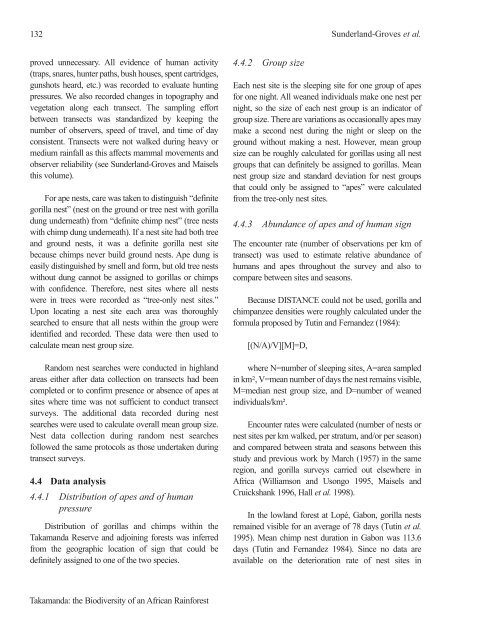Fisheries in the Southern Border Zone of Takamanda - Impact ...
Fisheries in the Southern Border Zone of Takamanda - Impact ...
Fisheries in the Southern Border Zone of Takamanda - Impact ...
You also want an ePaper? Increase the reach of your titles
YUMPU automatically turns print PDFs into web optimized ePapers that Google loves.
132 Sunderland-Groves et al.<br />
proved unnecessary. All evidence <strong>of</strong> human activity<br />
(traps, snares, hunter paths, bush houses, spent cartridges,<br />
gunshots heard, etc.) was recorded to evaluate hunt<strong>in</strong>g<br />
pressures. We also recorded changes <strong>in</strong> topography and<br />
vegetation along each transect. The sampl<strong>in</strong>g effort<br />
between transects was standardized by keep<strong>in</strong>g <strong>the</strong><br />
number <strong>of</strong> observers, speed <strong>of</strong> travel, and time <strong>of</strong> day<br />
consistent. Transects were not walked dur<strong>in</strong>g heavy or<br />
medium ra<strong>in</strong>fall as this affects mammal movements and<br />
observer reliability (see Sunderland-Groves and Maisels<br />
this volume).<br />
For ape nests, care was taken to dist<strong>in</strong>guish “def<strong>in</strong>ite<br />
gorilla nest” (nest on <strong>the</strong> ground or tree nest with gorilla<br />
dung underneath) from “def<strong>in</strong>ite chimp nest” (tree nests<br />
with chimp dung underneath). If a nest site had both tree<br />
and ground nests, it was a def<strong>in</strong>ite gorilla nest site<br />
because chimps never build ground nests. Ape dung is<br />
easily dist<strong>in</strong>guished by smell and form, but old tree nests<br />
without dung cannot be assigned to gorillas or chimps<br />
with confidence. Therefore, nest sites where all nests<br />
were <strong>in</strong> trees were recorded as “tree-only nest sites.”<br />
Upon locat<strong>in</strong>g a nest site each area was thoroughly<br />
searched to ensure that all nests with<strong>in</strong> <strong>the</strong> group were<br />
identified and recorded. These data were <strong>the</strong>n used to<br />
calculate mean nest group size.<br />
Random nest searches were conducted <strong>in</strong> highland<br />
areas ei<strong>the</strong>r after data collection on transects had been<br />
completed or to confirm presence or absence <strong>of</strong> apes at<br />
sites where time was not sufficient to conduct transect<br />
surveys. The additional data recorded dur<strong>in</strong>g nest<br />
searches were used to calculate overall mean group size.<br />
Nest data collection dur<strong>in</strong>g random nest searches<br />
followed <strong>the</strong> same protocols as those undertaken dur<strong>in</strong>g<br />
transect surveys.<br />
4.4 Data analysis<br />
4.4.1 Distribution <strong>of</strong> apes and <strong>of</strong> human<br />
pressure<br />
Distribution <strong>of</strong> gorillas and chimps with<strong>in</strong> <strong>the</strong><br />
<strong>Takamanda</strong> Reserve and adjo<strong>in</strong><strong>in</strong>g forests was <strong>in</strong>ferred<br />
from <strong>the</strong> geographic location <strong>of</strong> sign that could be<br />
def<strong>in</strong>itely assigned to one <strong>of</strong> <strong>the</strong> two species.<br />
<strong>Takamanda</strong>: <strong>the</strong> Biodiversity <strong>of</strong> an African Ra<strong>in</strong>forest<br />
4.4.2 Group size<br />
Each nest site is <strong>the</strong> sleep<strong>in</strong>g site for one group <strong>of</strong> apes<br />
for one night. All weaned <strong>in</strong>dividuals make one nest per<br />
night, so <strong>the</strong> size <strong>of</strong> each nest group is an <strong>in</strong>dicator <strong>of</strong><br />
group size. There are variations as occasionally apes may<br />
make a second nest dur<strong>in</strong>g <strong>the</strong> night or sleep on <strong>the</strong><br />
ground without mak<strong>in</strong>g a nest. However, mean group<br />
size can be roughly calculated for gorillas us<strong>in</strong>g all nest<br />
groups that can def<strong>in</strong>itely be assigned to gorillas. Mean<br />
nest group size and standard deviation for nest groups<br />
that could only be assigned to “apes” were calculated<br />
from <strong>the</strong> tree-only nest sites.<br />
4.4.3 Abundance <strong>of</strong> apes and <strong>of</strong> human sign<br />
The encounter rate (number <strong>of</strong> observations per km <strong>of</strong><br />
transect) was used to estimate relative abundance <strong>of</strong><br />
humans and apes throughout <strong>the</strong> survey and also to<br />
compare between sites and seasons.<br />
Because DISTANCE could not be used, gorilla and<br />
chimpanzee densities were roughly calculated under <strong>the</strong><br />
formula proposed by Tut<strong>in</strong> and Fernandez (1984):<br />
[(N/A)/V][M]=D,<br />
where N=number <strong>of</strong> sleep<strong>in</strong>g sites, A=area sampled<br />
<strong>in</strong> km 2, V=mean number <strong>of</strong> days <strong>the</strong> nest rema<strong>in</strong>s visible,<br />
M=median nest group size, and D=number <strong>of</strong> weaned<br />
<strong>in</strong>dividuals/km².<br />
Encounter rates were calculated (number <strong>of</strong> nests or<br />
nest sites per km walked, per stratum, and/or per season)<br />
and compared between strata and seasons between this<br />
study and previous work by March (1957) <strong>in</strong> <strong>the</strong> same<br />
region, and gorilla surveys carried out elsewhere <strong>in</strong><br />
Africa (Williamson and Usongo 1995, Maisels and<br />
Cruickshank 1996, Hall et al. 1998).<br />
In <strong>the</strong> lowland forest at Lopé, Gabon, gorilla nests<br />
rema<strong>in</strong>ed visible for an average <strong>of</strong> 78 days (Tut<strong>in</strong> et al.<br />
1995). Mean chimp nest duration <strong>in</strong> Gabon was 113.6<br />
days (Tut<strong>in</strong> and Fernandez 1984). S<strong>in</strong>ce no data are<br />
available on <strong>the</strong> deterioration rate <strong>of</strong> nest sites <strong>in</strong>

















